Publish Date (HKT) 2021-05-01
[PARTIALLY TRUE] Does British research show that a new technology can collect DNA from air, and that the new technology can detect human DNA everywhere?
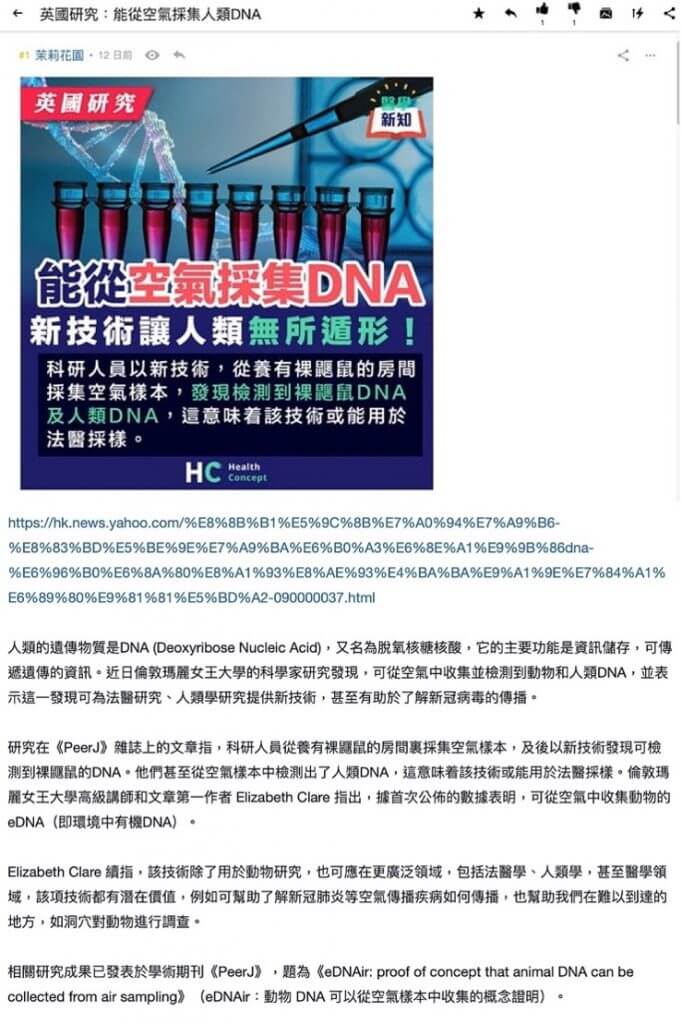
Screenshot of the LIHKG post.
Outline
- On April 16, 2021, an LIHKG user posted an article to the forum about a study claiming human DNA had been collected from air by a research team at Queen Mary University in London, along with an illustration stating that the new technology could detect human DNA everywhere.
- After checking the claim, the research team, led by Elizabeth Clare, senior lecturer at Queen Mary University and lead author of the paper, did indeed publish on March 31, 2021, an academic paper in the peer-reviewed journal PeerJ, in the field of biology and medicine, about the successful collection of mammalian DNA from air.
- However, the DNA collection technology used by the research team is not a new technology, as claimed in the LIHKG post. It is an already widely used technology that can collect environmental DNA (eDNA) from water. Furthermore, the air DNA (airDNA) collection technology used by the research team is currently only applicable for enclosed, indoor spaces, not for outdoor spaces. Also, the technology cannot “detect human DNA everywhere.”
- Therefore, we rate the claim as PARTIALLY TRUE.
News Brief
An LIHKG user posted to the forum on Apr. 26, 2021, an article titled “British research: human DNA can be collected from air.” The post quoted a news article published by the Hong Kong health information platform “Health Concept” on Yahoo News (see screenshot below). Later in the LIHKG thread, the same user posted a link to The Scientist, an online magazine for life science professionals, of an article titled “Environmental DNA can be pulled from the air: A proof-of-concept study uses eDNA in the air to detect mammals, expanding the technique beyond aquatic sampling.”

Illustration attached with the LIHKG post.
The LIHKG post references a study published in PeerJ, a peer-reviewed journal in the field of biology and medicine, by a research team at Queen Mary University in London. The post claims that researchers have used a new technology to detect naked mole rat DNA and human DNA from air samples, and this is the first time that animal environmental DNA (eDNA) has been collected from air. The post also quoted Elizabeth Clare, senior lecturer at Queen Mary University and lead author of the study, claiming the research has potential value in forensics, anthropology, medicine and other fields, and that “this technique could help us to better understand the transmission of airborne diseases such as COVID-19.”
As of the issuance of this report, the post had received 22 comments, one like and one dislike.
Fact-checking
The claim questions: Does British research show that a new technology can collect DNA from air, and that the new technology can detect human DNA everywhere?”
The research team led by Clare did publish an academic paper titled “eDNAir: proof of concept that animal DNA can be collected from air sampling” in the peer-reviewed journal PeerJ on March 31, 2021.

Screenshot of the academic paper published online.
According to the abstract, eDNA detection technology is one of the tools used for species biological monitoring and ecological research in aquatic ecosystems. The study proved for the first time that the existing eDNA collection technology can collect mixed templates from the air in a closed, indoor space. The eDNA and mixed templates can help identify the biological species in the enclosed space.
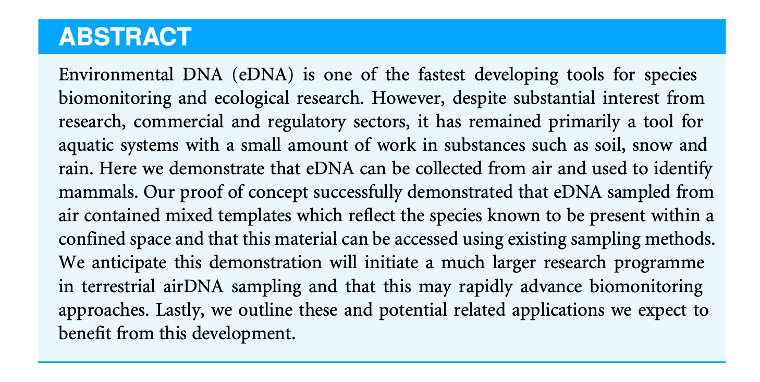
Screenshot of the research paper’s abstract.
The official website of Queen Mary University published a statement about the research. Elizabeth Clare, a senior lecturer with the School of Biological and Chemical Sciences at the university, said that the research helps understand how airborne diseases, such as COVID-19, are spread. She also said the technology “has some potential value in the fields of forensic medicine, anthropology, and even medicine,” which confirms the relevant statement in the LIHKG post that it “can collect human DNA from air.”
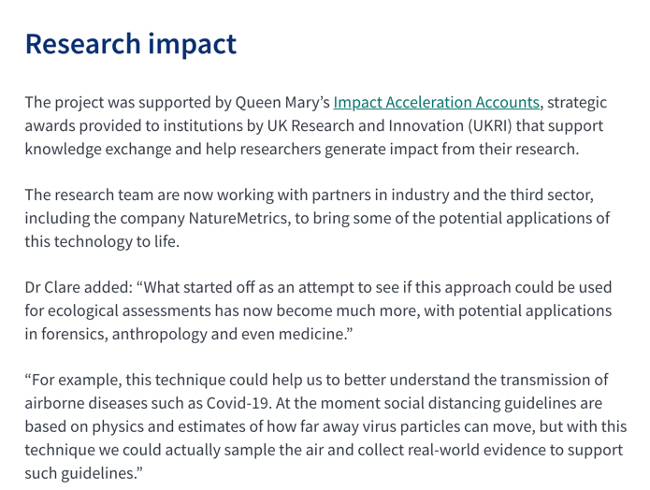
Screenshot of the statement about the academic paper.
However, the research paper also states the air DNA collection technology used by the team is a sampling method that already exists. The Scientist online magazine report on this research also pointed out the research team followed existing water eDNA sampling procedures. Elizabeth Clare herself mentioned in a research introduction video published on YouTube by the journal PeerJ that the method used by the team of filtering DNA from air (airDNA) is the same as the one of filtering eDNA from water. Therefore, Clare’s team used existing technology under new environmental conditions, and it was not a “new technology.” The claim that the technology is a new one is inaccurate.

Screenshot of the article published by The Scientist online magazine about the research.
In addition, although the study mentioned that the detection of human DNA in air samples has potential value for forensic research, it only shows that the sampled air DNA can be used to distinguish biological species that have appeared in a closed, indoor sampling environment, and the collection of human DNA can only prove that humans once existed in the area. This method is currently only suitable for closed, indoor environments with weak dilution effects, and not suitable for outdoor environments with strong dilution effects. Therefore, it is impossible that the technology can detect human DNA everywhere, and it is suspected to be exaggerated.
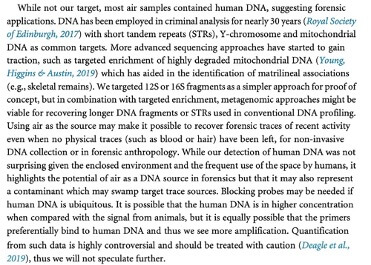
Screenshot of the research: potential forensic applications of airDNA.
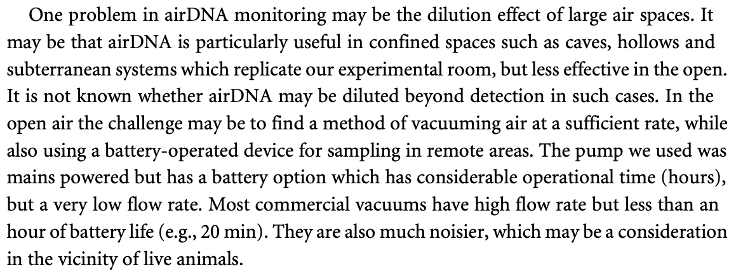
Screenshot of the research: airDNA detection technology only applicable to enclosed spaces.
Conclusion
There is indeed a British study stating there is a technology capable of collecting DNA from air, and human DNA was collected from air during the research process. However, the research is based on existing technology rather than new technology, and it is currently only applicable to closed, indoor environments, where the dilution effect is weak, and cannot be applied to outdoor environments. In addition, the study only uses DNA collected from air to identify whether a human was present in an enclosed area, and does not demonstrate any evidence that the technology can detect human DNA everywhere through air DNA samples.
Therefore, we rate the claim as PARTIALLY TRUE.
References
- LIHKG discussion forum, post, April 16, 2021.
- Yahoo News, “A British study: new technology of collecting DNA from air sampling and can detect human DNA everywhere,” April 14, 2021.
- The Scientist, “A proof-of-concept study uses eDNA in the air to detect mammals, expanding the technique beyond aquatic sampling,” April 7, 2021.
- PeerJ, “eDNAir: proof of concept that animal DNA can be collected from air sampling,” March 31, 2021.
- Queen Mary University of London, “Study provides first evidence of DNA collection from air,” March 31, 2021.
- Queen Mary University of London, Elizabeth Clare.
- YouTube Video, “eDNAir: proof of concept that animal DNA can be collected from air sampling,” March 31, 2021.












 :
: